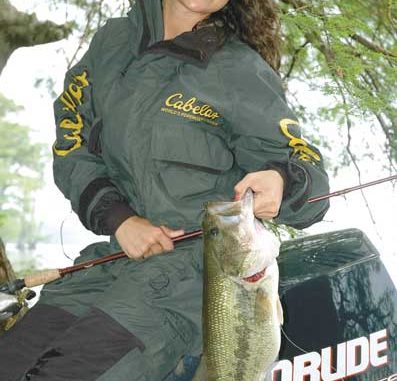
Get a good night’s sleep and hunt the mid-day hours at the mouth of the Mississippi River. The action’s best at this time of day.
In January, I’ll be fishing the marshes around the Bayou Black area, located between Houma and Morgan City, below Highway 90, where Kenyon Hill won the first BASS Top 100 tournament a few years ago. The last couple of storms that have come through Bayou Black haven’t hurt this region’s bass fishing as the storms did many other parts of the marshes.In the spring of 2007, plenty of anglers caught 14- to 18-pound limits of bass during tournaments in the marsh. However, a major drought devastated the area earlier this decade. In 1997, if you were fishing a bass tournament, there might be 10 limits of bass caught that weighed 20 pounds or more. But this year, the Bayou Black area is making a comeback with plenty of bass caught in the 1- to 3-pound range.
These January bass will be in the pre-spawn condition, and even may start spawning around the end of January, depending on the weather. I’ll primarily be targeting man-made dead-end canals where the bass will be moving to spawn, especially if Bayou Black has dirty water.
In clean water, I’ll be looking for the bass at the mouths of these dead-end canals. At this time of year, bass start moving out of the moving-water areas and into the dead-end canals in preparation for the spawn. Once you determine exactly where the bass are holding in the canals during January, you can wear them out.
At the beginning of January, I’ll start fishing the mouths of these canals, looking for grass, pilings or any structure the bass can hold on before they move into the back ends of the canals. I’ll fish moving baits like a spinnerbait, a Strike King Red Eye Shad or a jerkbait like the Wild Shiner in white, white/chartreuse or a baitfish pattern on 16- or 18-pound-test Gamma fluorocarbon line.
In clear water, I’ll be using a 3/8-ounce spinnerbait with a nickel-gold willowleaf blade combination. If the water’s muddy, I’ll use the same blade color, but I’ll change to a Colorado-style blade, and fish the spinnerbait slowly. If the water’s clear, I’ll fish the willowleaf spinnerbait faster.
If the bass don’t take the spinnerbait, I’ll fish the lipless Red Eye Shad by using a medium to fast retrieve, especially at the mouths of the canals with grass. I’m looking for isolated clumps of hydrilla or coontail moss growing in the middles and the mouths of those canals where bass will tend to group up around it.
I prefer to bang the Red Eye Shad on some type of cover like the bottom, crash it in the grass or rip it though grass. If the weather’s warm, I’ll rip the lipless crankbait out of the grass. If the weather’s cold, I’ll flutter it out of the grass (pull it slower). As soon as I jerk the bait free from the grass, I’ll let it fall and then start using my normal retrieve. At this time of year, I like a red crawfish pattern, gold/black or chrome/black Red Eye Shad.
In January, I also use the Wild Shiner jerkbait in chrome/black or gold/black, depending on whether the day’s cloudy or sunny, or if I’m fishing muddy or clear water. Because suspending jerkbaits dive deeply, there are very few places in Bayou Black where you can fish this lure. If the water’s really cold, I’ll weight a floating jerkbait with SuspenStrips or SuspenDots. This way, I can get the bait to suspend just under the surface above the grass.
Using SuspenDots and SuspenStrips was a popular fad a few years ago. Most fishermen forgot about this tactic, but I didn’t. Any time I need to get more depth on my crankbaits, use a surface bait as a suspending lure, reduce the speed at which a bait floats up or make a surface lure a sub-surface crankbait, I use these two little weighting systems.
The Wild Shiner floats well. Oftentimes, I use as many as 11 SuspenStrips to get the bait to suspend in that 1- to 4-foot-water depth where I know the bass are holding. I catch far more bass in January in Bayou Black by using weight to make the floating Wild Shiner suspend than I will when I try to make the Wild Shiner suspend by itself in that upper story of water.
If the area has calm conditions with no wind, I’ll fish the Wild Shiner on top just like I’ll fish a topwater lure. I’ll jerk it just under the surface and let it float back to the surface. None of the bass in the Bayou Black area this month will be deep. By weighting the jerkbait with the SuspenStrips, I can work the lure much slower and adjust the amount of time required for the jerkbait to float up after I’ve jerked it.
In January, I like to fish in and around Hackberry Lake, Bayou Chene, Bayou Black and the Orange Grove. These areas really turn on when the air temperature is in the mid-60s with wind and moving water on a falling tide. Falling water positions the fish on points or at the mouths of little drains and on pilings, making them easy to locate. The worst January condition is when a high tide with a hard wind comes out of the south, which makes the water not drain out of the marsh.


